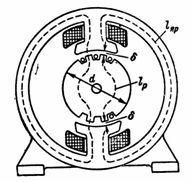Calculations of magnetic circuits
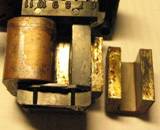 In electrical machines and apparatus, the magnetic flux F is concentrated in the magnetic circuit (ferromagnetic core) and the air gaps of this magnetic circuit. This path of magnetic flux is called a magnetic circuit.
In electrical machines and apparatus, the magnetic flux F is concentrated in the magnetic circuit (ferromagnetic core) and the air gaps of this magnetic circuit. This path of magnetic flux is called a magnetic circuit.
A magnetic circuit is like an electrical circuit. The magnetic flux Ф resembles an electric current I, the induction В resembles a current density, the magnetizing force (ns) Fн (H ∙ l = I ∙ ω) corresponds to e. etc. with
In the simplest case, the magnetic circuit has the same cross-section everywhere and is made of a homogeneous magnetic material. To determine n. with l ∙ ω required to provide the required induction B, the corresponding intensity H is determined from the magnetization curve and multiplied by the mean length of the magnetic field line l: H ∙ l = I ∙ ω = Fm.
From here, the required current I or the number of turns ω of the coil is determined.
A complex magnetic circuit usually has sections with different sections and magnetic materials. These sections are usually connected in series, therefore the same magnetic flux F passes through each of them.Induction B in each section depends on the cross-section of the section and is calculated for each section separately by the formula B = Φ∶S.
For different values of induction, the intensity H is determined from the magnetization curve and multiplied by the average length of the power line of the corresponding section of the circuit. Summing up the individual works, one gets the complete n. c. magnetic circuit:
Fm = I ∙ ω = H1 ∙ l1 + H2 ∙ l2 + H3 ∙ l3 + … which determines the magnetizing current or the number of coil turns.
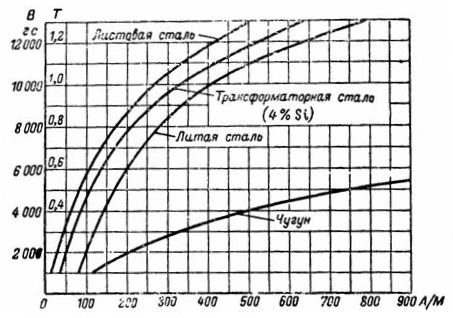
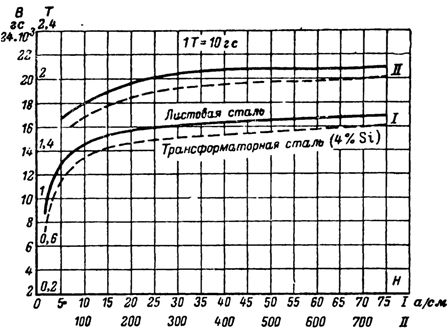
Magnetization curves
Examples of
1. What must be the magnetizing current I of a coil of 200 turns so that n. c. created in the cast iron ring a magnetic flux Ф = 15700 Ms = 0.000157 Wb? The average radius of the cast iron ring is r = 5 cm, and the diameter of its section is d = 2 cm (Fig. 1).
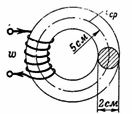
Rice. 1.
Section of the magnetic circuit S = (π ∙ d ^ 2) / 4 = 3.14 cm2.
The induction in the core is: B = Φ∶S = 15700∶3.14 = 5000 G.
In the MKSA system, the induction is: B = 0.000157 Wb: 0.0000314 m2 = 0.5 T.
From the magnetization curve of cast iron, we find the required strength H equal to 750 A / m for B = 5000 G = 0.5 T. The magnetizing strength is equal to: I ∙ ω = H ∙ l = 235.5 Av.
Therefore, the required current I = (H ∙ l) / ω = 235.5 / 200 = 1.17 A.
2. A closed magnetic circuit (Fig. 2) is made of steel plates of a transformer. How many turns must there be in a coil with a current of 0.5 A to create a magnetic flux in the core Ф = 160000 Ms = 0.0016 Wb?
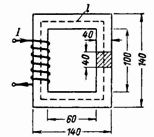
Rice. 2.
Core section S = 4 ∙ 4 = 16 cm2 = 0.0016 m2.
Core induction B = F / S = 160000/16 = 10000 Gs = 1 T.
According to the magnetization curve of the transformer steel, we find for B = 10,000 Gs = 1 T the intensity H = 3.25 A / cm = 325 A / m.
The average length of the magnetic field line is l = 2 ∙ (60 + 40) + 2 ∙ (100 + 40) = 480 = 0.48 m.
Magnetizing force Fm = I ∙ ω = H ∙ l = 3.25 ∙ 48 = 315 ∙ 0.48 = 156 Av.
At a current of 0.5 A, the number of turns is ω = 156 / 0.5 = 312.
3. The magnetic circuit shown in fig. 3 is similar to the magnetic circuit of the previous example, except that it has an air gap of δ = 5 mm. What should n be. s. and the coil current so that the magnetic flux is the same as in the previous example, i.e. F = 160000 Ms = 0.0016 Wb?
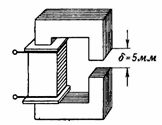
Rice. 3.
The magnetic circuit has two series-connected sections, the cross-section of which is the same as in the previous example, i.e. S = 16 cm2. Inductance is also equal to B = 10000 G = 1 T.
The average length of the steel magnetic line is slightly shorter: lс = 48-0.5 = 47.5 cm ≈0.48 m.
The magnetic voltage in this section of the magnetic circuit is Hc ∙ lc = 3.25 ∙ 48≈156 Av.
The field strength in the air gap is: Hδ = 0.8 ∙ B = 0.8 ∙ 10000 = 8000 A / cm.
The magnetic tension in the cross-section of the air gap Hδ ∙ δ = 8000 ∙ 0.5 = 4000 Av.
Complete n. c. is equal to the sum of magnetic voltages in individual sections: I ∙ ω = Hс ∙ lс + Hδ ∙ δ = 156 + 4000 = 4156 Av. I = (I ∙ ω) / ω = 4156/312 = 13.3 A.
If in the previous example the required magnetic flux was provided by a current of 0.5 A, then for a magnetic circuit with an air gap of 0.5 cm a current of 13 A is required to obtain the same magnetic flux. From this it can be seen that an air gap, even insignificant in relation to the length of the magnetic circuit, greatly increases the required n. v. and coil current.
4. The magnetic flux of the transformer is calculated to be F = 72000 Ms. Calculation of n is required.s.and magnetizing current of the primary winding having 800 turns. There is a gap δ = 0.2 mm in the core of the transformer. The dimensions of the transformer core are shown in fig. 4. Cross section of the core S = 2 ∙ 3 = 6 cm2 (transformers with cores of this shape are called armored).
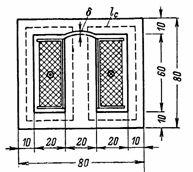
Rice. 4.
Core and air gap induction B = F / S = 72000/6 = 12000 G.
According to the magnetization curve of the transformer steel for B = 12000 G, we determine the intensity: Hc = 5 A / cm.
The average length of the magnetic line in steel is lс = 2 ∙ (6 + 3) = 18 cm.
Voltage in the air gap Hδ = 0.8 ∙ B = 9600 A / cm.
Magnetizing force I ∙ ω = Hc ∙ lc + Hδ ∙ δ = 5 ∙ 18 + 9600 ∙ 0.02 = 90 + 192 = 282 Av; I = (I ∙ ω) / ω = 282/800 = 0.35 A.
In the armored core, the magnetic flux splits into two parts, which are closed along the side rods, the cross section of which is S / 2, and the average length of the magnetic line is lc. As a result, the magnetic circuit is completely analogous to the magnetic circuit of a conventional transformer with a common core S and a length of the power line lc.
5. The magnetic flux of the DC machine F = 1280000 Mks. The magnetic circuit contains a cast steel yoke with an average magnetic line length lа = 80 cm, a rotor assembled from electric steel plates with an average field length lр = 18 cm, and two air gaps δ 0.2 cm each. = 8 ∙ 20 cm2; rotor and pole section Sр = 12 ∙ 20 cm2... Calculate n. p. and the number of turns of the pole coil, if the maximum magnetizing (exciting) current in it is 1 A (Fig. 5).
Rice. 5.
Induction in the yoke and the pole Bя = Ф / Sя = 1280000/160 = 8000 G.
The voltage in the yoke and pole according to the magnetization curve of cast steel at Bя = 8000 G is equal to:
H = 2.8 A / cm.
The force of magnetization in the section of the yoke HЯ ∙ la = 2.8 ∙ 80 = 224 Av.
Induction in the rotor, pole and air gap Br = Ф / Ср = 1280000/240 = 5333 G.
Voltage in a rotor made of steel plates at Br = 5333 Gs Hrp = 0.9 A / cm,
and the magnetic voltage of the rotor section Hр ∙ lр = 0.9 ∙ 18 = 16.2 Av.
Voltage in the air gap Hδ = 0.8 ∙ Bδ = 0.8 ∙ 5333 = 4266.4 A / cm.
The magnetic voltage in the cross section of the air gap Hδ ∙ 2 ∙ δ = 4266.4 ∙ 2 ∙ 0.2 = 1706.56 A.
Complete n. c. equal to the sum of magnetic voltages in separate sections: I ∙ ω = Hя ∙ la + Hр ∙ lр + Hδ ∙ 2 ∙ δ; I ∙ ω = 224 + 16.2 + 1706.56 = 1946.76 Av.
The number of turns in the two pole coils ω = (I ∙ ω) / I = 1946.76 / 1≈2000.

